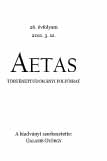Nyelvében él a polgár? (Többnyelvűség a késő-középkori Magyarország városaiban)
Integration through Language: the Multi-lingual Character of Late Medieval Hungarian Towns
Author(s): Katalin SzendeSubject(s): History
Published by: AETAS Könyv- és Lapkiadó Egyesület
Summary/Abstract: The paper assesses the ethnically heterogeneous nature of urban population in the medieval Kingdom of Hungary from the point of view of language usage. Literacy and orality with regard to the languages used by the indigenous (Hungarian, Slovak, Croatian, and so forth) and immigrant (German, Italian, Walloon and other), Christian and non-Christian elements are discussed both on a countrywide basis and on the level of individual towns. The examples taken from a number of towns in the medieval Kingdom of Hungary, from Žilina in the north to Dubrovnik in the south, from Sopron in the west to Braşov in the east, show both the integrative role of language and its limitations. On the one hand, by understanding and, in some contexts (especially in commerce, daily life and diplomacy), by using the languages of the ‘others’, various ethnic groups could avoid segregation. On the other hand, by maintaining situations (partly in administration and jurisdiction, and especially in religious life) when the use of their mother tongue was not only permitted but even required, they consciously counteracted assimilation. It was only in very few and isolated instances that the use of a single language was made compulsory. Through the analysis of available data using tools borrowed from historical sociolingusitics, we can gain deeper insight into the multi-lingual character of late medieval Hungarian towns. The author points out various elements of bilingualism and diglossia, and emphasizes the different and changing level of prestige of Latin and the various vernaculars. This helps explain language choices on the individual and community level, and understand how social and cultural development as well as changes in the ethnic structure of urban populations affected and were reflected in the use of various languages.
Journal: AETAS - Történettudományi folyóirat
- Issue Year: 2011
- Issue No: 3
- Page Range: 5-26
- Page Count: 22
- Language: Hungarian

